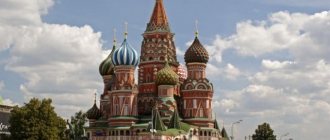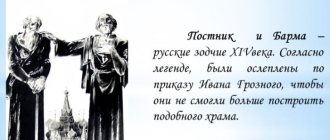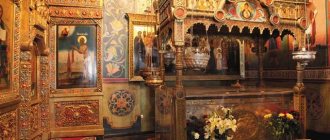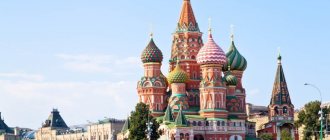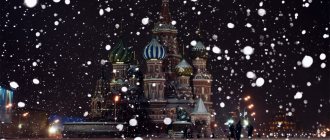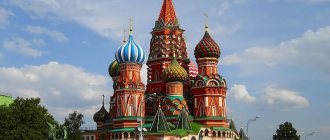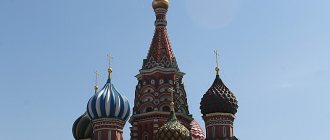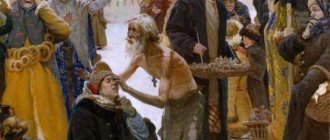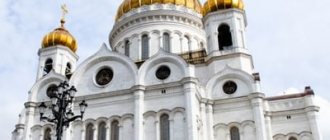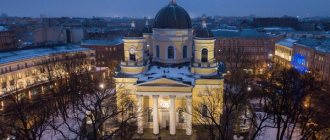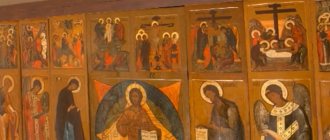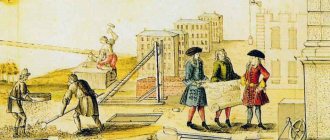Short story
On July 12, 2011, the most famous Orthodox church in Russia, the Intercession Cathedral, or St. Basil's Cathedral, celebrated its 450th anniversary.
Located on Red Square next to the Kremlin, it has become a symbol of Moscow and the whole country. St. Basil's Cathedral is a whole city in the city: 10 churches with colorful domes were built on a single foundation. It was built in 1555 - 1561 by order of Ivan the Terrible to commemorate the victory over the Kazan Khanate
- the age-old enemy of Rus'.
View of the cathedral from the Moscow Kremlin
An old Moscow legend says that during the decisive assault on Kazan, Ivan the Terrible went to the camp church, located in a tent, and prayed fervently. But barely the priest had time to utter the words: “And there will be one flock and one shepherd,” when the earth shook from a powerful explosion, and part of the enemy fortifications flew into the air, opening the way for the Russian troops.
For the first time in the history of Rus', it included not a principality, but an entire state - the Kazan Khanate. The capture of Kazan had not only political significance (now the Russians controlled the Volga-Baltic trade route), but also religious significance - it was a campaign against the infidels. In Moscow, the townspeople greeted Ivan the Terrible with loud cries: “Many years to the pious Tsar, conqueror of the barbarians, savior of the Orthodox people!”
Monument to Minin and Pozharsky against the backdrop of St. Basil's Cathedral
Another version is a legend
The Intercession Church was erected in 1555-1561 by Russian architects Barma and Postnik Yakovlev (or perhaps it was the same master - Ivan Yakovlevich Barma). There is a well-known legend that, having seen the temple, Ivan the Terrible ordered the craftsmen to be blinded so that they could not build such a miracle anywhere else. As if when the king asked whether the master could build another equally beautiful temple or an even better one, he answered defiantly: “I can!” - and angered the king. "You are lying!" - cried the Terrible and ordered to deprive both eyes so that this temple would remain the only one. Popular rumor spread the rumor that Ivan the Terrible supposedly built this temple in honor of his father, Grand Duke Vasily III: “People will remember me even without churches for a thousand years, but I want my parent to be remembered.” That’s why the temple is supposedly called St. Basil’s.
The design of the Intercession Cathedral is based on the apocalyptic symbolism of the Heavenly Jerusalem. The eight chapters, located around the central ninth tent, form a geometric figure in plan from two squares combined at an angle of 45 degrees, in which it is easy to see an eight-pointed star.
The number 8 symbolizes the day of the Resurrection of Christ, which according to the Hebrew calendar was the eighth day, and the coming Kingdom of Heaven - the Kingdom of the “eighth century” (or “eighth kingdom”), which will come after the Second Coming of Christ - after the end of earthly history associated with the apocalyptic number 7.
The square expresses the firmness and constancy of faith and is a cosmic symbol of the Universe: its four equal sides mean the four cardinal directions, the four winds of the Universe, the four ends of the cross, the four canonical Gospels, the four evangelist apostles, the four equilateral walls of Heavenly Jerusalem. The combined squares symbolize the preaching of the Gospels to the four cardinal directions, that is, to the whole world.
The eight-pointed star - a reminder of the Star of Bethlehem, which showed the Magi the way to the infant Christ, the Savior of the world - symbolizes the entire Christian Church as a guiding star in human life to the Heavenly Jerusalem. The eight-pointed star is also a symbol of the Most Holy Theotokos - the Lady of the Church and the Queen of Heaven: in Orthodox iconography, the Mother of God is depicted in a maforia (veil) with three eight-pointed stars on her shoulders and on her forehead as a sign of Her Eternal Virginity - before, during and after the Nativity of Christ.
The throne in honor of the Intercession of the Mother of God is located in the central tented church, which unites the remaining chapters, as if gathering them around itself. This symbolizes the primacy, protection and intercession of the Mother of God over the Church of Christ and over the entire Russian land. In Russian temple construction, a tent symbolizes a canopy (canopy), which from ancient times was erected over a sacred place as a sign of its God-protectedness and holiness.
St. Basil's Cathedral - a masterpiece of unknown architects
Initially, on the site of the future temple there was a wooden Church of the Holy Trinity, but in 1555 they began to build a stone cathedral, which still exists. Who was the main architect remains a mystery. According to one version, the tsar invited the Pskov master Postnik Yakovlev, nicknamed Barma; according to another, the names Postnik and Barma belong to two different architects.
According to the third version, St. Basil's Cathedral is a project of an Italian architect. There is a legend that the king ordered the eyes of the creator of the cathedral to be gouged out so that he could no longer repeat his masterpiece. But if we consider Postnik to be the author of the cathedral, then this legend does not find documentary evidence. Postnik could not have been blinded, since for several years after the completion of construction he worked on the project of the Kazan Kremlin.
View of the cathedral from Vasilyevsky Spusk
St. Basil's Cathedral - an outlandish constellation of tents and domes
St. Basil's Cathedral is crowned with 10 domes. 8 churches, located symmetrically around the main temple in the form of an eight-pointed star, symbolize church holidays
, falling on the days of the decisive battles for Kazan. There are 8 onion-shaped domes installed on their tops. The central Church of the Intercession of the Virgin Mary is completed with a tent with a small dome, and the tenth dome is built above the bell tower.
All 9 churches are united by a single base and an internal bypass gallery, painted with intricate floral patterns. None of the domes is the same as the other. St. Basil's Cathedral was not always so colorful. The white stone and brick used in the construction of the church gave it austerity and restraint.
View of the cathedral from Red Square
In the 17th century, the domes of the cathedral were decorated with ceramic tiles, asymmetrical extensions were added, tents were erected over the porches, and the walls were covered with intricate paintings. In 1931, a bronze Monument to Minin and Pozharsky, which previously stood on Red Square, was erected in front of the cathedral.
St. Basil's Cathedral - a temple to the glory of the wonderworker
The main church of the temple was consecrated in honor of the Feast of the Intercession of the Blessed Virgin Mary
. However, the Intercession Church is called St. Basil's Cathedral and is associated not with Ivan the Terrible and the Kazan campaigns, but with the name of the Moscow holy fool - the man of God. Vasily lived on the streets of Moscow and even in severe frost he walked half naked, wearing chains on his body - iron chains with crosses. Ivan the Terrible himself treated him with reverence
Baths of the cathedral
When Vasily became seriously ill, the Tsar visited him with his wife, Tsarina Anastasia. A number of miracles are attributed to the saint. While in Moscow, he put out a fire in Novgorod with three bowls of wine. Vasily exposed lies, and under external piety he could guess the actions of the devil. So, in front of the amazed pilgrims’ eyes, he threw a stone at the image of the Mother of God, which was revered as miraculous. When the crowd began to beat Vasily, he shouted: “And you will scrape the primer!” Having removed the paint layer, people saw that a devil was drawn under the image of the Mother of God. Vasily died in 1552, and in 1588 a church was built over the burial site of the relics of the wonderworker. This extension gave the common name to the Intercession Church - St. Basil's Cathedral.
Cathedral Baths
Tradition claims that until 1595 the royal treasury was kept in the dungeons of the temple. Today the cathedral is jointly managed by the Historical Museum of Moscow and the Russian Orthodox Church. On Sundays, services are held there.
Attraction rating
Rating 4.71 [42 vote(s)]
| ← MOSCOW CATHEDRALS | MOSCOW → |
Temple structure
There are only 10 domes. Nine domes over the temple (according to the number of thrones):
- Intercession of the Virgin Mary (central),
- Holy Trinity (East),
- Entry of the Lord into Jerusalem (zap.),
- Gregory of Armenia (north-west),
- Alexander Svirsky (southeast),
- Varlaam Khutynsky (southwest),
- John the Merciful (formerly John, Paul and Alexander of Constantinople) (north-east),
- Nicholas the Wonderworker of Velikoretsky (south),
- Adrian and Natalia (formerly Cyprian and Justina) (northern))
- plus one dome over the bell tower.
The cathedral consists of eight churches, the thrones of which were consecrated in honor of the holidays that occurred during the decisive battles for Kazan:
- Trinity,
- in honor of St. Nicholas the Wonderworker (in honor of his Velikoretskaya icon from Vyatka),
- Entry into Jerusalem
- in honor of the martyr. Adrian and Natalia (originally - in honor of St. Cyprian and Justina - October 2),
- St. John the Merciful (until XVIII - in honor of St. Paul, Alexander and John of Constantinople - November 6),
- Alexander Svirsky (April 17 and August 30),
- Varlaam Khutynsky (November 6 and 1st Friday of Peter's Lent),
- Gregory of Armenia (September 30).
All these eight churches (four axial, four smaller ones between them) are crowned with onion domes and grouped around the ninth pillar-shaped church rising above them in honor of the Intercession of the Mother of God, completed with a tent with a small dome. All nine churches are united by a common base, a bypass (originally open) gallery and internal vaulted passages.
In 1588, a chapel was added to the cathedral from the northeast, consecrated in honor of St. Basil the Blessed (1469-1552), whose relics were located on the site where the cathedral was built. The name of this chapel gave the cathedral a second, everyday name. Adjacent to the chapel of St. Basil's is the chapel of the Nativity of the Blessed Virgin Mary, in which Blessed John of Moscow was buried in 1589 (at first the chapel was consecrated in honor of the Deposition of the Robe, but in 1680 it was reconsecrated as the Nativity of the Theotokos). In 1672, the discovery of the relics of St. John the Blessed took place there, and in 1916 it was reconsecrated in the name of Blessed John, the Moscow wonderworker.
A tented bell tower was built in the 1670s.
The cathedral has been restored several times. In the 17th century, asymmetrical extensions were added, tents over the porches, intricate decorative treatment of the domes (originally they were gold), and ornamental paintings outside and inside (originally the cathedral itself was white).
In the main, Intercession, church there is an iconostasis from the Kremlin Church of the Chernigov Wonderworkers, dismantled in 1770, and in the chapel of the Entrance to Jerusalem there is an iconostasis from the Alexander Cathedral, dismantled at the same time.
The last (before the revolution) rector of the cathedral, Archpriest John Vostorgov, was shot on August 23 (September 5), 1919. Subsequently, the temple was transferred to the disposal of the renovation community.
First floor
Podklet
There are no basements in the Intercession Cathedral. Churches and galleries stand on a single foundation - a basement, consisting of several rooms. The strong brick walls of the basement (up to 3 m thick) are covered with vaults. The height of the premises is about 6.5 m.
The design of the northern basement is unique for the 16th century. Its long box vault has no supporting pillars. The walls are cut with narrow openings - vents. Together with the “breathable” building material - brick - they provide a special indoor microclimate at any time of the year.
Previously, the basement premises were inaccessible to parishioners. The deep niches in it were used as storage. They were closed with doors, the hinges of which have now been preserved.
Until 1595, the royal treasury was hidden in the basement. Wealthy townspeople also brought their property here.
One entered the basement from the upper central Church of the Intercession of Our Lady via an internal white stone staircase. Only the initiated knew about it. Later this narrow passage was blocked. However, during the restoration process of the 1930s. a secret staircase was discovered.
In the basement there are icons of the Intercession Cathedral. The oldest of them is the icon of St. St. Basil's at the end of the 16th century, written specifically for the Intercession Cathedral.
Two 17th-century icons are also on display. - “Protection of the Most Holy Theotokos” and “Our Lady of the Sign”.
The icon “Our Lady of the Sign” is a replica of the façade icon located on the eastern wall of the cathedral. Written in the 1780s. In the XVIII-XIX centuries. The icon was located above the entrance to the chapel of St. Basil the Blessed.
Church of St. Basil the Blessed
The lower church was added to the cathedral in 1588 over the burial place of St. St. Basil's. A stylized inscription on the wall tells about the construction of this church after the canonization of the saint by order of Tsar Fyodor Ioannovich.
The temple is cubic in shape, covered with a cross vault and crowned with a small light drum with a dome. The roof of the church is made in the same style as the domes of the upper churches of the cathedral.
The oil painting of the church was done for the 350th anniversary of the start of construction of the cathedral (1905). The dome depicts the Savior Almighty, the forefathers are depicted in the drum, the Deesis (Savior Not Made by Hands, the Mother of God, John the Baptist) is depicted in the crosshairs of the vault, and the Evangelists are depicted in the sails of the vault.
On the western wall is the temple image of the “Protection of the Blessed Virgin Mary”. In the upper tier there are images of the patron saints of the reigning house: Fyodor Stratelates, John the Baptist, Saint Anastasia, and the Martyr Irene.
On the northern and southern walls there are scenes from the life of St. Basil: “The Miracle of Salvation at Sea” and “The Miracle of the Fur Coat.” The lower tier of the walls is decorated with a traditional ancient Russian ornament in the form of towels.
The iconostasis was completed in 1895 according to the design of the architect A.M. Pavlinova. The icons were painted under the guidance of the famous Moscow icon painter and restorer Osip Chirikov, whose signature is preserved on the icon “The Savior on the Throne”.
The iconostasis includes earlier icons: “Our Lady of Smolensk” from the 16th century. and the local image of “St. Saint Basil against the backdrop of the Kremlin and Red Square" XVIII century.
Above the burial place of St. St. Basil's Church is installed, decorated with a carved canopy. This is one of the revered Moscow shrines.
On the southern wall of the church there is a rare large-sized icon painted on metal - “Our Lady of Vladimir with selected saints of the Moscow circle “Today the most glorious city of Moscow flaunts brightly” (1904)
The floor is covered with Kasli cast iron slabs.
St. Basil's Church was closed in 1929. Only at the end of the 20th century. its decorative decoration was restored. August 15, 1997, on the day of memory of St. Basil the Blessed, Sunday and holiday services were resumed in the church.
Second floor
Galleries and porches
An external bypass gallery runs along the perimeter of the cathedral around all the churches. Initially it was open. In the middle of the 19th century. the glazed gallery became part of the cathedral's interior. Arched entrance openings lead from the external gallery to the platforms between the churches and connect it with internal passages.
The central Church of the Intercession of Our Lady is surrounded by an internal bypass gallery. Its vaults hide the upper parts of the churches. In the second half of the 17th century. the gallery was painted with floral patterns. Later, narrative oil paintings appeared in the cathedral, which were updated several times. Tempera painting is currently unveiled in the gallery. Oil paintings from the 19th century have been preserved on the eastern section of the gallery. — images of saints in combination with floral patterns.
Carved brick portals-entrances leading to the central church organically complement the decor of the internal gallery. The southern portal has been preserved in its original form, without later coatings, which allows you to see its decoration. The relief details are laid out from specially molded pattern bricks, and the shallow decoration is carved on site.
Previously, daylight penetrated into the gallery from windows located above the passages in the walkway. Today it is illuminated by mica lanterns from the 17th century, which were previously used during religious processions. The multi-domed tops of the outrigger lanterns resemble the exquisite silhouette of a cathedral.
The floor of the gallery is made of brick in a herringbone pattern. Bricks from the 16th century have been preserved here. - darker and more resistant to abrasion than modern restoration bricks.
The vault of the western section of the gallery is covered with a flat brick ceiling. It demonstrates a unique for the 16th century. engineering technique for constructing a floor: many small bricks are fixed with lime mortar in the form of caissons (squares), the edges of which are made of figured bricks.
In this area, the floor is laid out with a special “rosette” pattern, and on the walls the original painting has been recreated, imitating brickwork. The size of the drawn bricks corresponds to the real ones.
Two galleries unite the chapels of the cathedral into a single ensemble. Narrow internal passages and wide platforms create the impression of a “city of churches.” After passing through the labyrinth of the internal gallery, you can get to the porch areas of the cathedral. Their vaults are “carpets of flowers,” the intricacies of which fascinate and attract the attention of visitors.
On the upper platform of the northern porch in front of the Church of the Entry of the Lord into Jerusalem, the bases of pillars or columns have been preserved - the remains of the decoration of the entrance. This is due to the special role of the church in the complex ideological program of the cathedral’s dedications.
Church of Alexander Svirsky
The southeastern church was consecrated in the name of St. Alexander of Svirsky.
In 1552, on the day of memory of Alexander Svirsky, one of the important battles of the Kazan campaign took place - the defeat of the cavalry of Tsarevich Yapancha on the Arsk field.
This is one of four small churches 15 m high. Its base - a quadrangle - turns into a low octagon and ends with a cylindrical light drum and a vault.
The original appearance of the church interior was restored during restoration work in the 1920s and 1979-1980s: a brick floor with a herringbone pattern, profiled cornices, stepped window sills. The walls of the church are covered with paintings imitating brickwork. The dome depicts a “brick” spiral - a symbol of eternity.
The iconostasis of the church has been reconstructed. Icons from the 16th - early 18th centuries are located between the wooden beams (tyablas) close to each other. The lower part of the iconostasis is covered with hanging shrouds, skillfully embroidered by craftswomen. On the velvet shrouds there is a traditional image of the Calvary cross.
Church of Varlaam Khutynsky
The southwestern church was consecrated in the name of St. Varlaam of Khutyn.
This is one of the four small churches of the cathedral with a height of 15.2 m. Its base has the shape of a quadrangle, elongated from north to south with the apse shifted to the south. The violation of symmetry in the construction of the temple is caused by the need to create a passage between the small church and the central one - the Intercession of the Mother of God.
The four turns into a low eight. The cylindrical light drum is covered with a vault. The church is illuminated by the oldest chandelier in the cathedral from the 15th century. A century later, Russian craftsmen supplemented the work of the Nuremberg masters with a pommel in the shape of a double-headed eagle.
The Tyablo iconostasis was reconstructed in the 1920s. and consists of icons from the 16th – 18th centuries. A feature of the church’s architecture—the irregular shape of the apse—determined the shift of the Royal Doors to the right.
Of particular interest is the separately hanging icon “The Vision of Sexton Tarasius”. It was written in Novgorod at the end of the 16th century. The plot of the icon is based on the legend about the vision of the sexton of the Khutyn monastery of disasters threatening Novgorod: floods, fires, “pestilence”.
The icon painter depicted the panorama of the city with topographical accuracy. The composition organically includes scenes of fishing, plowing and sowing, telling about the daily life of the ancient Novgorodians.
Church of the Entry of the Lord into Jerusalem
The Western Church was consecrated in honor of the Feast of the Entry of the Lord into Jerusalem.
One of the four large churches is an octagonal two-tier pillar covered with a vault. The temple is distinguished by its large size and the solemn nature of its decorative decoration.
During the restoration, fragments of architectural decoration from the 16th century were discovered. Their original appearance has been preserved without restoration of damaged parts. No ancient paintings were found in the church. The whiteness of the walls emphasizes the architectural details, executed by architects with great creative imagination. Above the northern entrance there is a trace left by a shell that hit the wall in October 1917.
The current iconostasis was moved in 1770 from the dismantled Alexander Nevsky Cathedral in the Moscow Kremlin. It is richly decorated with openwork gilded pewter overlays, which add lightness to the four-tier structure. In the middle of the 19th century. The iconostasis was supplemented with wooden carved details. The icons in the bottom row tell the story of the Creation of the world.
The church displays one of the shrines of the Intercession Cathedral - the icon “St. Alexander Nevsky in the Life of the 17th century. The icon, unique in its iconography, probably comes from the Alexander Nevsky Cathedral.
In the middle of the icon the noble prince is represented, and around him there are 33 stamps with scenes from the life of the saint (miracles and real historical events: the Battle of the Neva, the prince’s trip to the Khan’s headquarters, the Battle of Kulikovo).
Church of Gregory of Armenia
The northwestern church of the cathedral was consecrated in the name of St. Gregory, the enlightener of Great Armenia (died in 335). He converted the king and the entire country to Christianity, and was the bishop of Armenia. His memory is celebrated on September 30 (October 13 n.st.). In 1552, on this day, an important event in the campaign of Tsar Ivan the Terrible took place - the explosion of the Arsk Tower in Kazan.
One of the four small churches of the cathedral (15m high) is a quadrangle, turning into a low octagon. Its base is elongated from north to south with a displacement of the apse. The violation of symmetry is caused by the need to create a passage between this church and the central one - the Intercession of Our Lady. The light drum is covered with a vault.
The architectural decoration of the 16th century has been restored in the church: ancient windows, half-columns, cornices, brick floor laid out in a herringbone pattern. As in the 17th century, the walls are whitewashed, which emphasizes the severity and beauty of the architectural details.
The tyablovy (tyabla are wooden beams with grooves between which icons were attached) iconostasis was reconstructed in the 1920s. It consists of windows from the 16th-17th centuries. The Royal Doors are shifted to the left - due to a violation of the symmetry of the internal space.
In the local row of the iconostasis is the image of St. John the Merciful, Patriarch of Alexandria. Its appearance is connected with the desire of the wealthy investor Ivan Kislinsky to re-consecrate this chapel in honor of his heavenly patron (1788). In the 1920s the church was returned to its former name.
The lower part of the iconostasis is covered with silk and velvet shrouds depicting Calvary crosses. The interior of the church is complemented by the so-called “skinny” candles - large wooden painted candlesticks of an antique shape. In their upper part there is a metal base in which thin candles were placed.
The display case contains items of priestly vestments from the 17th century: a surplice and a phelonion, embroidered with gold threads. The 19th century candilo, decorated with multi-colored enamel, gives the church a special elegance.
Church of Cyprian and Justina
The northern church of the cathedral has an unusual dedication for Russian churches in the name of the Christian martyrs Cyprian and Justina, who lived in the 4th century. Their memory is celebrated on October 2 (15). On this day in 1552, the troops of Tsar Ivan IV took Kazan by storm.
This is one of the four large churches of the Intercession Cathedral. Its height is 20.9 m. The high octagonal pillar is completed with a light drum and a dome, which depicts Our Lady of the Burning Bush. In the 1780s. Oil painting appeared in the church. On the walls are scenes of the lives of saints: in the lower tier - Adrian and Natalia, in the upper - Cyprian and Justina. They are complemented by multi-figure compositions on the theme of Gospel parables and scenes from the Old Testament.
The appearance of images of martyrs of the 4th century in painting. Adrian and Natalia is associated with the renaming of the church in 1786. Rich investor Natalya Mikhailovna Khrushcheva donated funds for repairs and asked to consecrate the church in honor of her heavenly patrons. At the same time, a gilded iconostasis was made in the style of classicism. It is a magnificent example of skillful wood carving. The bottom row of the iconostasis depicts scenes of the Creation of the World (days one and four).
In the 1920s, at the beginning of scientific museum activities in the cathedral, the church was returned to its original name. Recently, it appeared before visitors updated: in 2007, the wall paintings and iconostasis were restored with the charitable support of the Russian Railways Joint Stock Company.
Church of St. Nicholas Velikoretsky
The southern church was consecrated in the name of the Velikoretsk Icon of St. Nicholas the Wonderworker. The icon of the saint was found in the city of Khlynov on the Velikaya River and subsequently received the name “Nicholas of Velikoretsky”.
In 1555, by order of Tsar Ivan the Terrible, the miraculous icon was brought in a religious procession along the rivers from Vyatka to Moscow. An event of great spiritual significance determined the dedication of one of the chapels of the Intercession Cathedral under construction.
One of the large churches of the cathedral is a two-tier octagonal pillar with a light drum and a vault. Its height is 28 m.
The ancient interior of the church was badly damaged during the fire of 1737. In the second half of the 18th - early 19th centuries. a single complex of decorative and fine arts emerged: a carved iconostasis with full ranks of icons and monumental plot painting of the walls and vault. The lower tier of the octagon presents the texts of the Nikon Chronicle about the bringing of the image to Moscow and illustrations to them.
In the upper tier the Mother of God is depicted on a throne surrounded by prophets, above are the apostles, in the vault is the image of the Savior Almighty.
The iconostasis is richly decorated with stucco floral decoration and gilding. The icons in narrow profiled frames are painted in oil. In the local row there is an image of “St. Nicholas the Wonderworker in the Life” of the 18th century. The lower tier is decorated with gesso engraving imitating brocade fabric.
The interior of the church is complemented by two external double-sided icons depicting St. Nicholas. They made religious processions around the cathedral.
At the end of the 18th century. The floor of the church was covered with white stone slabs. During restoration work, a fragment of the original covering made of oak checkers was discovered. This is the only place in the cathedral with a preserved wooden floor.
In 2005-2006 The iconostasis and monumental paintings of the church were restored with the assistance of the Moscow International Currency Exchange.
Holy Trinity Church
The eastern one is consecrated in the name of the Holy Trinity. It is believed that the Intercession Cathedral was built on the site of the ancient Trinity Church, after which the entire temple was often named.
One of the four large churches of the cathedral is a two-tiered octagonal pillar, ending with a light drum and a dome. Its height is 21 m. During the restoration of the 1920s. In this church, the ancient architectural and decorative decoration was most fully restored: half-columns and pilasters framing the entrance arches of the lower part of the octagon, the decorative belt of the arches. In the vault of the dome, a spiral is laid out with small bricks - a symbol of eternity. Stepped window sills in combination with the whitewashed surface of the walls and vault make the Trinity Church especially bright and elegant. Under the light drum, “voices” are built into the walls - clay vessels designed to amplify sound (resonators). The church is illuminated by the oldest chandelier in the cathedral, made in Russia at the end of the 16th century.
Based on restoration studies, the shape of the original, so-called “tyabla” iconostasis was established (“tyabla” are wooden beams with grooves between which the icons were fastened close to each other). The peculiarity of the iconostasis is the unusual shape of the low royal doors and three-row icons, forming three canonical orders: prophetic, Deesis and festive.
“The Old Testament Trinity” in the local row of the iconostasis is one of the most ancient and revered icons of the cathedral of the second half of the 16th century.
Church of the Three Patriarchs
The northeastern church of the cathedral was consecrated in the name of the three Patriarchs of Constantinople: Alexander, John and Paul the New.
In 1552, on the day of remembrance of the Patriarchs, an important event of the Kazan campaign took place - the defeat by the troops of Tsar Ivan the Terrible of the cavalry of the Tatar prince Yapanchi, who was coming from the Crimea to help the Kazan Khanate.
This is one of the four small churches of the cathedral with a height of 14.9 m. The walls of the quadrangle turn into a low octagon with a cylindrical light drum. The church is interesting for its original ceiling system with a wide dome, in which the composition “The Savior Not Made by Hands” is located.
The wall oil painting was made in the mid-19th century. and reflects in its plots the then change in the name of the church. In connection with the transfer of the throne of the cathedral church of Gregory of Armenia, it was reconsecrated in memory of the enlightener of Great Armenia.
The first tier of the painting is dedicated to the life of St. Gregory of Armenia, in the second tier - the history of the image of the Savior Not Made by Hands, its bringing to King Abgar in the Asia Minor city of Edessa, as well as scenes from the lives of the Patriarchs of Constantinople.
The five-tier iconostasis combines baroque elements with classical ones. This is the only altar barrier in the cathedral from the mid-19th century. It was made specifically for this church.
In the 1920s, at the beginning of scientific museum activity, the church was returned to its original name. Continuing the traditions of Russian philanthropists, the management of the Moscow International Currency Exchange contributed to the restoration of the interior of the church in 2007. For the first time in many years, visitors were able to see one of the most interesting churches of the cathedral.
Central Church of the Intercession of the Virgin Mary
Bell tower
The modern bell tower of the Intercession Cathedral was built on the site of an ancient belfry.
By the second half of the 17th century. the old belfry had become dilapidated and unusable. In the 1680s. it was replaced by a bell tower, which still stands today.
The base of the bell tower is a massive high quadrangle, on which an octagon with an open platform is placed. The site is fenced with eight pillars connected by arched spans and crowned with a high octagonal tent.
The ribs of the tent are decorated with multi-colored tiles with white, yellow, blue and brown glaze. The edges are covered with figured green tiles. The tent is completed by a small onion dome with an eight-pointed cross. There are small windows in the tent - the so-called “rumors”, designed to amplify the sound of the bells.
Inside the open area and in the arched openings, bells cast by outstanding Russian craftsmen of the 17th-19th centuries are suspended on thick wooden beams. In 1990, after a long period of silence, they began to be used again.
The height of the temple is 65 meters.
